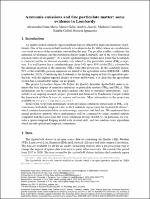Chapter Ammonia emissions and fine particulate matter: some evidence in Lombardy
| dc.contributor.author | Salis, Matteo | |
| dc.contributor.author | Zucchi, Andrea | |
| dc.contributor.author | FUSTA MORO, ALESSANDRO | |
| dc.contributor.author | Cameletti, Michela | |
| dc.contributor.author | GOLINI, Natalia | |
| dc.contributor.author | Ignaccolo, Rosaria | |
| dc.date.accessioned | 2023-08-03T15:06:34Z | |
| dc.date.available | 2023-08-03T15:06:34Z | |
| dc.date.issued | 2023 | |
| dc.identifier | ONIX_20230803_9791221501063_108 | |
| dc.identifier.issn | 2704-5846 | |
| dc.identifier.uri | https://library.oapen.org/handle/20.500.12657/74912 | |
| dc.description.abstract | Lombardy is one of the most polluted regions at the European level, also due to its particular geographical structure and weather conditions which prevent the pollutants’ dispersion, and the high levels of emissions coming from human activities. Recently, some evidence has been found regarding the relationship between agriculture and air quality, particularly between ammonia - produced mainly by the livestock sector - and particulate matter concentrations. In this respect, Lombardy is the first Italian region for agriculture production, having 69% of its area classified as agricultural land and about 245 swine and 92 bovines per rural km2. In the Agriculture Impact On Italian Air project (AgrImOnIA, https://agrimonia.net, funded by Fondazione Cariplo within the framework of Data Science for science and society), we aim to predict continuously in space (i.e. mapping) air pollutants concentrations in Lombardy region, taking into account meteorology, land use and emissions coming from agriculture. In this regard, data integration and harmonization process have been carried out starting from data from different sources and characterized by different spatial and temporal resolutions. The first results are based on spatio-temporal Kriging models, with external drift, and an extension of the traditional random forest algorithm to consider the spatial and temporal correlation. These models will be used to generate scenario analysis which simulates the impact of policy interventions in the agricultural sector to mitigate its environmental impact on air quality. | |
| dc.language | English | |
| dc.relation.ispartofseries | Proceedings e report | |
| dc.subject.classification | thema EDItEUR::J Society and Social Sciences | en_US |
| dc.subject.other | Spatio-temporal Kriging | |
| dc.subject.other | Random Forest | |
| dc.subject.other | Predictive modeling | |
| dc.subject.other | Air quality | |
| dc.subject.other | Agriculture emissions | |
| dc.title | Chapter Ammonia emissions and fine particulate matter: some evidence in Lombardy | |
| dc.type | chapter | |
| oapen.identifier.doi | 10.36253/979-12-215-0106-3.40 | |
| oapen.relation.isPublishedBy | 9223d3ac-6fd2-44c9-bb99-5b98ca9d2fad | |
| oapen.relation.isPartOfBook | 863aa499-dbee-4191-9a14-3b5d5ef9e635 | |
| oapen.relation.isbn | 9791221501063 | |
| oapen.series.number | 134 | |
| oapen.pages | 6 | |
| oapen.place.publication | Florence |

